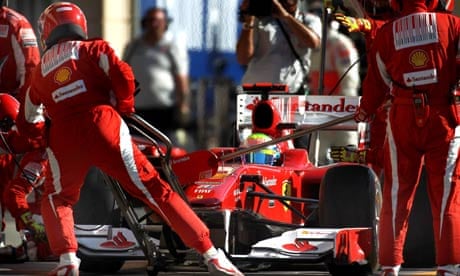Every fortnight during the summer I come second to a plethora of noisy vehicles. Formula One has arrived and those cars on the screen are seen by my godson and mates as some of the coolest objects on the planet. Anything associated with this world, however subliminally, is cool too. I know, I'm a specialist in brand positioning.
But don't listen to me. Just watch a shocking video put together by Cancer Research UK, where primary school children chat about cigarette packs. One child takes one look at a Marlboro pack and simply says "Ferrari". I suspect that's why Philip Morris is willing to continue to pay an estimated £100m a year in sponsorship to this F1 team despite being banned from making any link to the Marlboro brand name. Another gazes at a cigarette pack and says "it makes you feel like you're in a wonderland of happiness".
And this is where my problem starts. I don't normally jump on soapboxes. If adults choose to shorten their lives by smoking I can't criticise – I've been there. But when an industry marketing products that are the UK's single greatest cause of preventable illness and early death protests that "there is no proof to suggest that the plain packaging of tobacco products will be effective in discouraging young people to smoke" (British American Tobacco on plain packaging) I feel obliged to stand up and be counted.
They got me at the age of 13. Back then their quest for my attention started with advertising, but it was the slim silvery green pack perfectly complementing my other accessories that coerced me into an addiction that took 25 years to break. It clinched the three-second decision process. So you can imagine my anxiety as I listen to my young godson and friends debate the merits of one tobacco brand over another; anxiety heightened by my awareness of positioning and media strategies.
I have worked with, or had cause to research, many brands that cannot target young people directly, either for legal reasons or because they're monitored for "pester power". Subliminal visual cues and connection are therefore key – through social media, in-game placement, brand extensions such as characters and games, and, most overtly, packaging design. The power of packaging is simply demonstrated by the reduced popularity of a certain children's sweet brand. My own recent research with teenagers found that simply by switching pack shape the brand no longer inspires their imagination. All that is left are small sugar-coated chocolates, with previously bright colours tamed by elimination of chemical additives, now competing less successfully with a plethora of similar imported competitors.
The tobacco industry therefore has no choice but to keep packaging design firmly in its sights. Let's face facts. Every year 100,000 smokers die in the UK and must be replaced to avoid industry obsolescence. Smoking is an addiction most commonly started in childhood, with two thirds of smokers taking up the habit while under 18, and smokers are typically brand loyal. To succeed, tobacco companies have to attract new young smokers. They can't advertise at them, they can't promote to them, so the only vehicle with which to attract attention is packaging.
When Imperial Tobacco introduced its Lambert and Butler celebration pack in 2004 market share increased by 0.4% – doesn't sound like much until you do the numbers and realise this was worth over £60m in additional turnover in just four months. Commenting on this "success" Imperial Tobacco's global brand director, Geoff Good, stated that "the pack design was the only part of the mix that was changed, and therefore we knew the cause and effect".
The industry argues that packaging innovation is about encouraging adults to switch brands, not enticing youngsters to start smoking, that standardised packs will not reduce the number of young people taking up smoking. This is clearly untrue; from my own experience and from Cancer Research UK's explorations with very young people, it is clear that the more attractive the cigarette pack the more likely it is that kids will aspire to the brand as part of their lifestyle portfolio.
Why do I care? Because tobacco is like no other product. There is no safe level of consumption and the product kills when used as intended. That's why it's impossible to argue against plain packaging.
The Australians have shown the way – they're putting cigarettes in a standard brown pack with large health warnings from December this year. We must do the same. That's what I'll be saying when I respond to the government consultation currently under way, because I don't want my godson to be a Marlboro man. I want him to live a long and healthy life.
